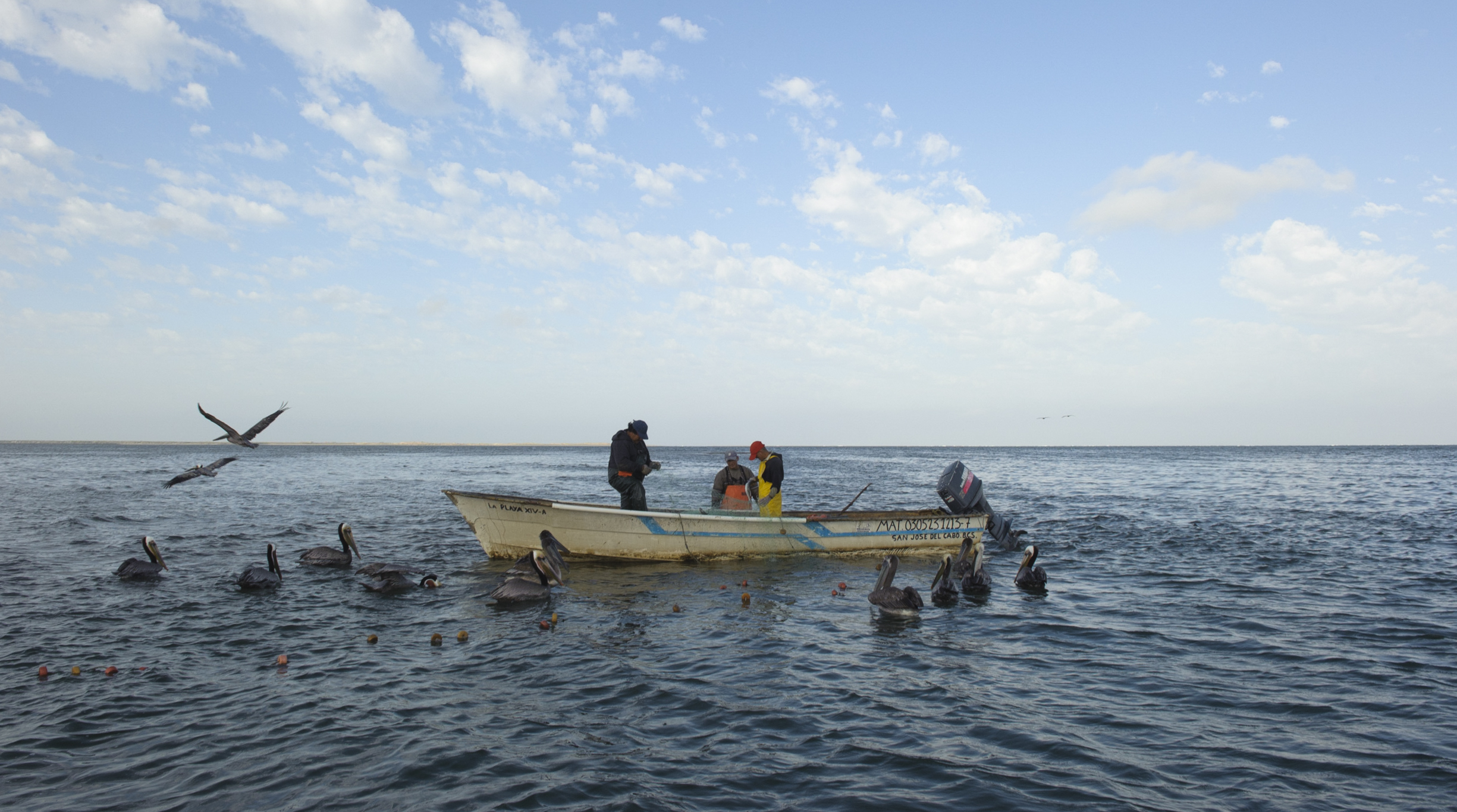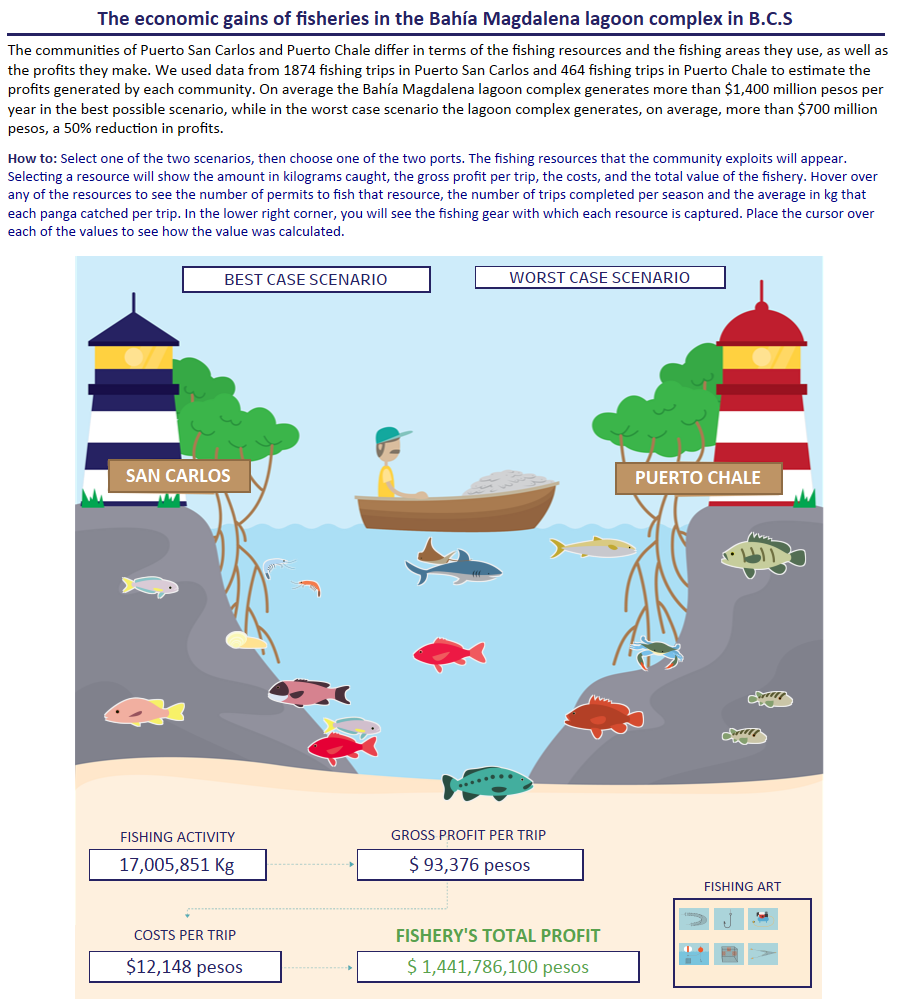Keywords:
Economic value of fishing activity in the lagoon complex of Bahía Magdalena-Almejas, B.C.S., Mexico.

The communities of Puerto San Carlos and Puerto Chale are part of the Bahía Magdalena-Almejas (BMA) lagoon complex. However, they differ in terms of the fishing resources and fishing areas they use, and the profits they make. Puerto San Carlos, located in the central zone within the complex, is the largest community and with the largest fishing fleet (646 pangas). Its most important fishery resources are: clams, crab and shrimp (2). Puerto Chale, located to the south of the complex, has 112 pangas and depends mainly on 12 species that are extracted from the canals, mangrove and even from outside the lagoon complex (1).

Since 2012, with the help of fishermen we have monitored the fisheries in the region in order to understand the fishing dynamics of these communities. Realizing the differences that exist between communities, we decided to make an initial economic assessment exercise to evaluate the contribution of each fishery to the local and regional economy. We have estimated total profits for 15 fisheries that we have monitored in Puerto San Carlos and Puerto Chale since 2012: goeduck (Panopea generosa), bullseye puffer (Sphoeroides annulatus), blue and brown shrimp (Litopenaeus stylirostris, Farfantepenaeus californiensis), Pacific red snapper (Lutjanus peru) , whitefish (Caulolatilus princeps), blue crab (Callinectes sp), sharks and mantas (Mustelus sp., Carcharhinus sp., Sphyrna sp., Rhinoptera steindachneri), star-studded grouper (Hyporthodus niphobles), Yellowtail (Seriola lalandi), groupers (Epinephelus sp., Mycteroperca sp.), snappers (Lutjanus sp.), Barred sand bass (Paralabrax nebulifer) y California sheephead (Semicossyphus pulcher). Cost and profit calculations were performed with data generated in 2016 through our Collaborative Science Program (PCC) (3), which includes fishery catch data from 2,338 fishing trips. We calculate the cost of gasoline using the average cost (in liters) per fishing trip and the average price per liter of gasoline in 2016. The total cost of the fishing gear used in each fishery was calculated by adding the price of the gear and the cost of repairs carried out during the total time each particular fishing gear is used (useful life of equipment, gillnet or hook and line). The result is divided by the number of fisheries where the same fishing gear is used. We calculate an average for the price per kilogram of catch for each species using our data generated in 2016. In addition, we simulate two scenarios: (1) best-case scenario: when the different fisheries obtain the best revenue, or a good fishing season; and (2) worse-case scenario: when profits are reduced or performance drops by 50%. Our common denominator is the number of trips per fishery per season.
Major Findings:
In the best scenario, we estimate that fishing generates more than $ 1,300 million pesos in Puerto San Carlos and 55 million pesos in Puerto Chale, annually. When conditions in the fisheries are adverse, a bad scenario, profits are reduced by almost 50% ($ 760 million pesos for Puerto San Carlos and $ 27 million pesos for Puerto Chale). In Puerto San Carlos, the goeduck, brown and blue shrimp fisheries are the ones that generate the greatest profits: on average, each panga produces more than 3 million pesos per year for each of these fisheries. In Puerto Chale, star-studded grouper, whitefish, and shark / manta fisheries are the most economically productive: on average, each boat fishing star-tudded grouper produces more than 400 thousand pesos a year, while whitefish and shark / manta fisheries generate more than 200 thousand pesos a year, per fishing vessel.
Authors:
Victoria Jiménez-Esquivel*, Juan José Cota Nieto*, Ismael Mascareñas Osorio*, Dayana Méndez*, y Octavio Aburto**
Contact Information:
victoria.jimenez@gocmarineprogram.org
DOI:
10.13022/M3459R
Affiliations:
* Centro para la Biodiversidad Marina y la Conservación A.C., La Paz B.C.S. ** Scripps Institution of Oceanography, San Diego, CA., U.S.A.
Acknowledgements:
NA
How to cite this story:
Victoria Jiménez-Esquivel, Juan José Cota Nieto, Ismael Mascareñas Osorio, Dayana Méndez y Octavio Aburto-Oropeza (2017): Economic value of fishing activity in the lagoon complex of Bahía Magdalena-Almejas, B.C.S., Mexico. dataMares. InteractiveResource. https://doi.org/10.13022/M3459R
References
(2) J. José Cota-Nieto, Victoria Jiménez-Esquivel, Ismael Mascareñas-Osorio (2015): La pesca en Bahía Magdalena - Almejas: motor económico para B.C.S. DataMares. Interactive Resource: http://dx.doi.org/10.13022/M3GW2F
(3) Comprender las interacciones entre el ecosistema y los componentes biológicos, económicos y sociales de una pesquería es fundamental para desarrollar estrategias de manejo que promuevan la pesca sostenible. La extracción de recursos necesita acomodar diversos usos y objetivos a través de múltiples escalas y sectores. Esto puede ser social y políticamente desafiante debido al número de personas involucradas y su alta dependencia de los recursos costeros y marinos como alimento y recursos de subsistencia. Nos hemos asociado con pescadores y comunidades locales para generar datos pesqueros, biológicos, económicos y espaciales con el fin de identificar y comprender las interacciones entre las actividades de pesca artesanal, las especies objetivo, las especies protegidas y las AMPs.

